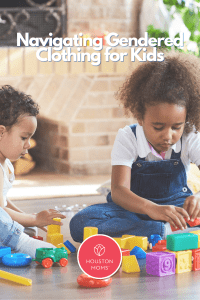My oldest child is a girl, and I knew early on that I didn’t want her life to be buckets of pink and bows and glitter. One of the values of my parenting is allowing my kids to discover who they are and what they are into, so I wanted to expose her to a variety of things as she explores. Of course, we still ended up with some of the ruffles and bows (it’s the South after all), but overall her wardrobe is focused on function, not fashion. When our second child came along, it was a boy, and that opened up a whole new world of gendered clothing challenges, since the box of what is “acceptable” is much smaller for boys. Over the years I’ve learned some tips and tricks of minimizing gender when it comes to my kids’ clothes.
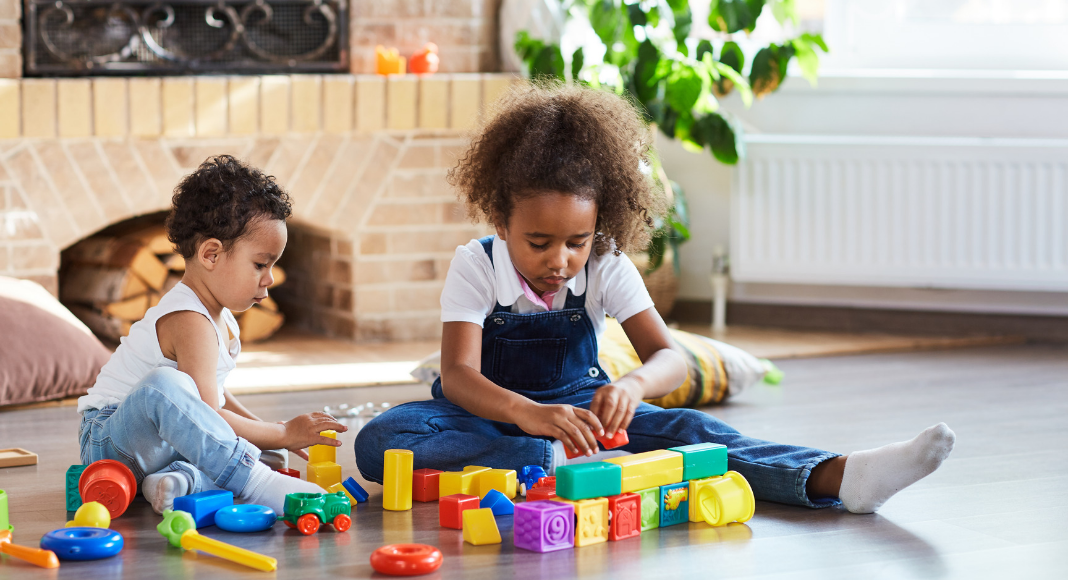 Establish Your Clothing Goal
Establish Your Clothing Goal
My goal in dressing my children most days is for them to be comfortable and be able to move and play. This is the foundation of how I make clothing decisions. Is something itchy, confining, or uncomfortable? Pass. I reason that they will have enough opportunities to wear uncomfortable clothing when they become adults. I firmly believe that play is the work of childhood, and I dress them for that job. For example, I tend to avoid dresses since they are more likely to get in the way of climbing, riding bikes, or crawling. We also exclusively wear boy’s underwear because it doesn’t bunch or ride up like girl’s underwear tends to do.
Choose A Uniform
The easiest way to make clothing decisions less work is to choose a uniform and just vary it every day. In the summer, my kids are in t-shirts and shorts. In the winter, pants and long sleeved t-shirts, with a jacket thrown in as needed. There are exceptions to the rule of course, for special events or church, but most days my kids are wearing the same thing. Even if we get “fancy” as we call it in my house, we still stick to our comfort rule, wearing things that can be played in. Last year when my daughter was a flower girl I even brought a reception outfit for her to change into after the ceremony so she would not need to wear the long lace flower girl dress all night.
Have Your Go-To Stores
I don’t typically spend a lot on my kids clothes, since I expect them to be pretty rough on them. My go to shopping places are Target, Carters, Old Navy, and H&M. Knowing your stores allows you to make better decisions when shopping. For example, I know that Target’s leggings tend to hold up best for us, so I usually get them there. Old Navy is my go to for rompers, which are my favorite summer staple for chubby baby legs, and Carters is where we typically get our pajamas. When it comes time to buy for a new season, I know what I am getting where, so I don’t have to reinvent the wheel.
Know How to Navigate the Sections
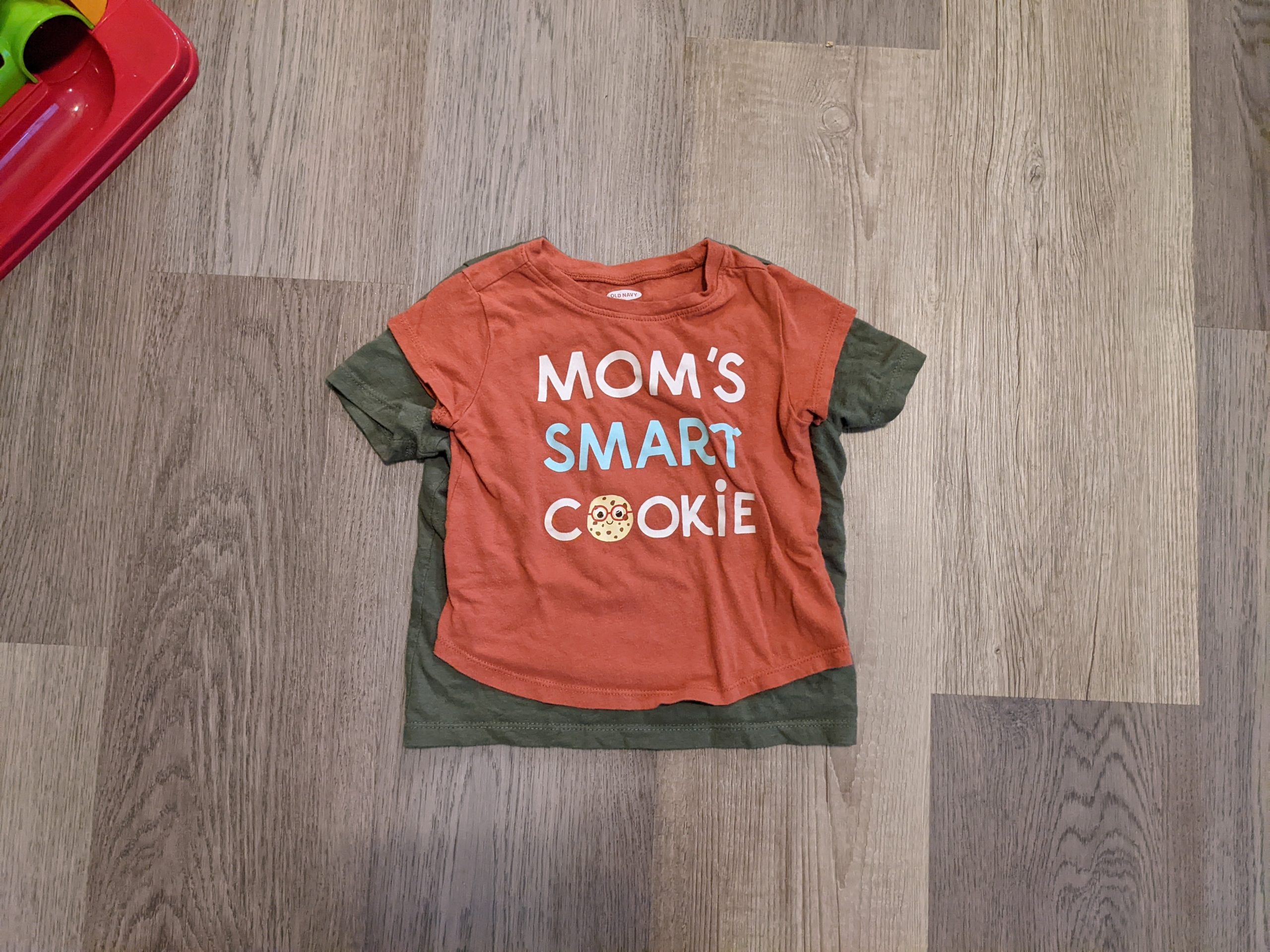 Most children’s clothing is sorted into “boys” and “girls” sections. I shop a blend of these sections. Boys get few colors when it comes to bottoms, limited often to just navy or gray, while girls get a variety of patterns and colors. Girl’s shirts tend to run small, as we’ve decided that even female toddlers need to wear things that are tighter and shorter, so I tend to mostly buy shirts in the boy’s section, and size up if I get something from the girls’ side. Don’t believe me? See photo above. Both of these shirts are from the same store, and are the same size. The green one is from the boy’s section and the red one is from the girl’s. Pajamas don’t seem to vary much, so those can be from either one. Don’t limit yourself to one side of the store. Explore all of your options. You never know what you might discover!
Most children’s clothing is sorted into “boys” and “girls” sections. I shop a blend of these sections. Boys get few colors when it comes to bottoms, limited often to just navy or gray, while girls get a variety of patterns and colors. Girl’s shirts tend to run small, as we’ve decided that even female toddlers need to wear things that are tighter and shorter, so I tend to mostly buy shirts in the boy’s section, and size up if I get something from the girls’ side. Don’t believe me? See photo above. Both of these shirts are from the same store, and are the same size. The green one is from the boy’s section and the red one is from the girl’s. Pajamas don’t seem to vary much, so those can be from either one. Don’t limit yourself to one side of the store. Explore all of your options. You never know what you might discover!
Avoid Hyper Gendered Messages
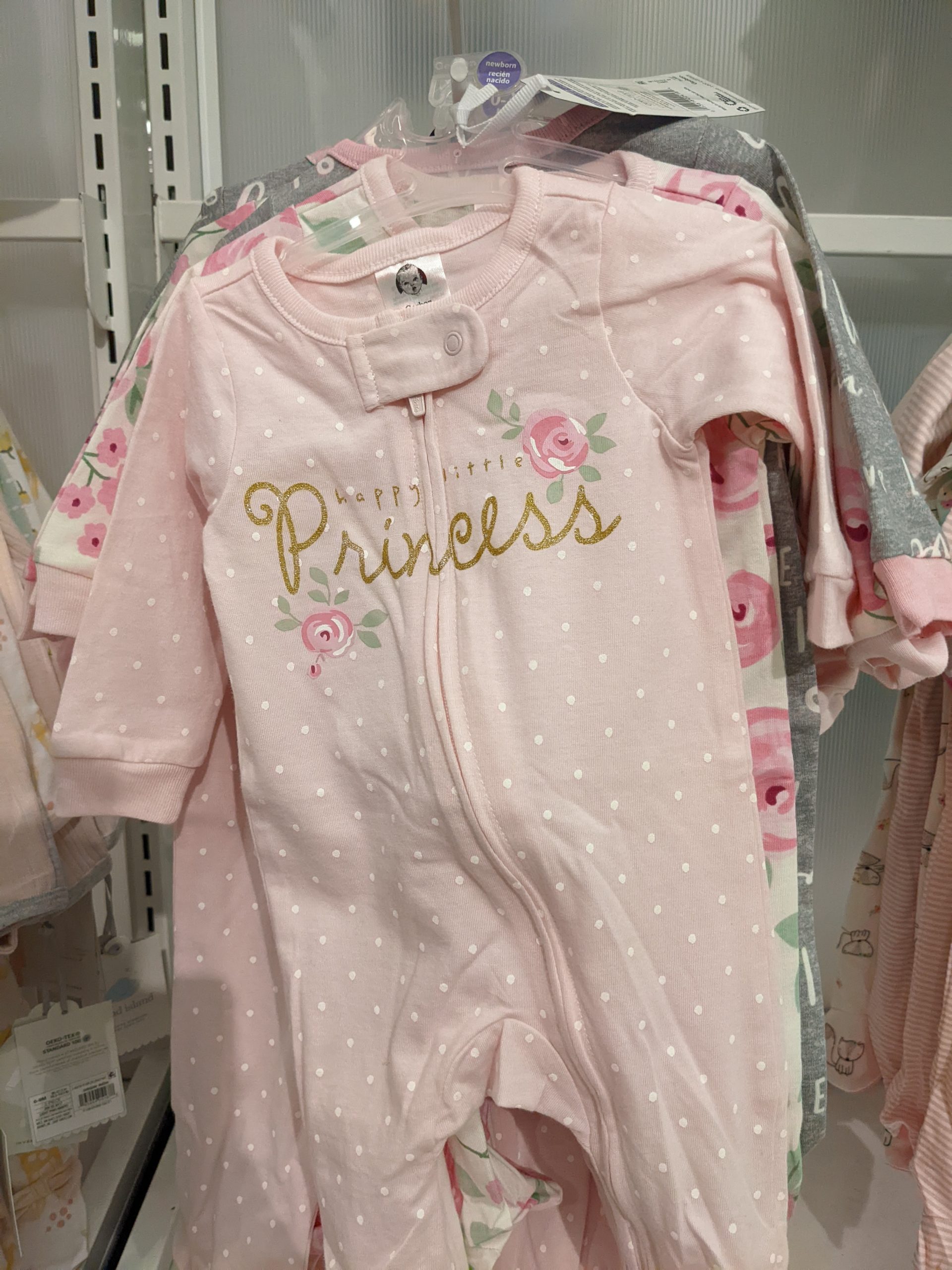 “Mommy’s Strong Man” “Daddy’s Little Girl” “Watch Out Ladies!” “Girl Power!” Our kids get enough messages about their gender every day without needing it on their clothes as well. And don’t even get me started on the sexualization of little boys and how freaking weird it is. I don’t tend to buy things with phrases like these on them. If nothing else, it makes it harder to use as a hand me down since I have opposite gendered kids.
“Mommy’s Strong Man” “Daddy’s Little Girl” “Watch Out Ladies!” “Girl Power!” Our kids get enough messages about their gender every day without needing it on their clothes as well. And don’t even get me started on the sexualization of little boys and how freaking weird it is. I don’t tend to buy things with phrases like these on them. If nothing else, it makes it harder to use as a hand me down since I have opposite gendered kids.
Set Boundaries with Gifts
We found out gender both times we were expecting, and I set boundaries around clothing pretty quickly. For our daughter, I asked that people not buy everything pink and frilly. For our son, I asked them to stay away from sexual messages, construction equipment, and sports themes (we aren’t a sports family). For the most part, people respected those boundaries, and if not, I have no problem sorting them into the donation bin.
Follow Your Child’s Lead
As my daughter has gotten older, I’ve been able to tailor her clothes to her interests. She has a lot of Mickey and Frozen shirts, and a good amount of blue in her wardrobe, as it is her current favorite color. That will likely evolve as her interests change, and if she eventually wants to choose her own clothes, then I will continue to follow her lead. Our son is too young to have specific interests yet, but when the time comes we will do the same for him.
Push Back on Stereotypes
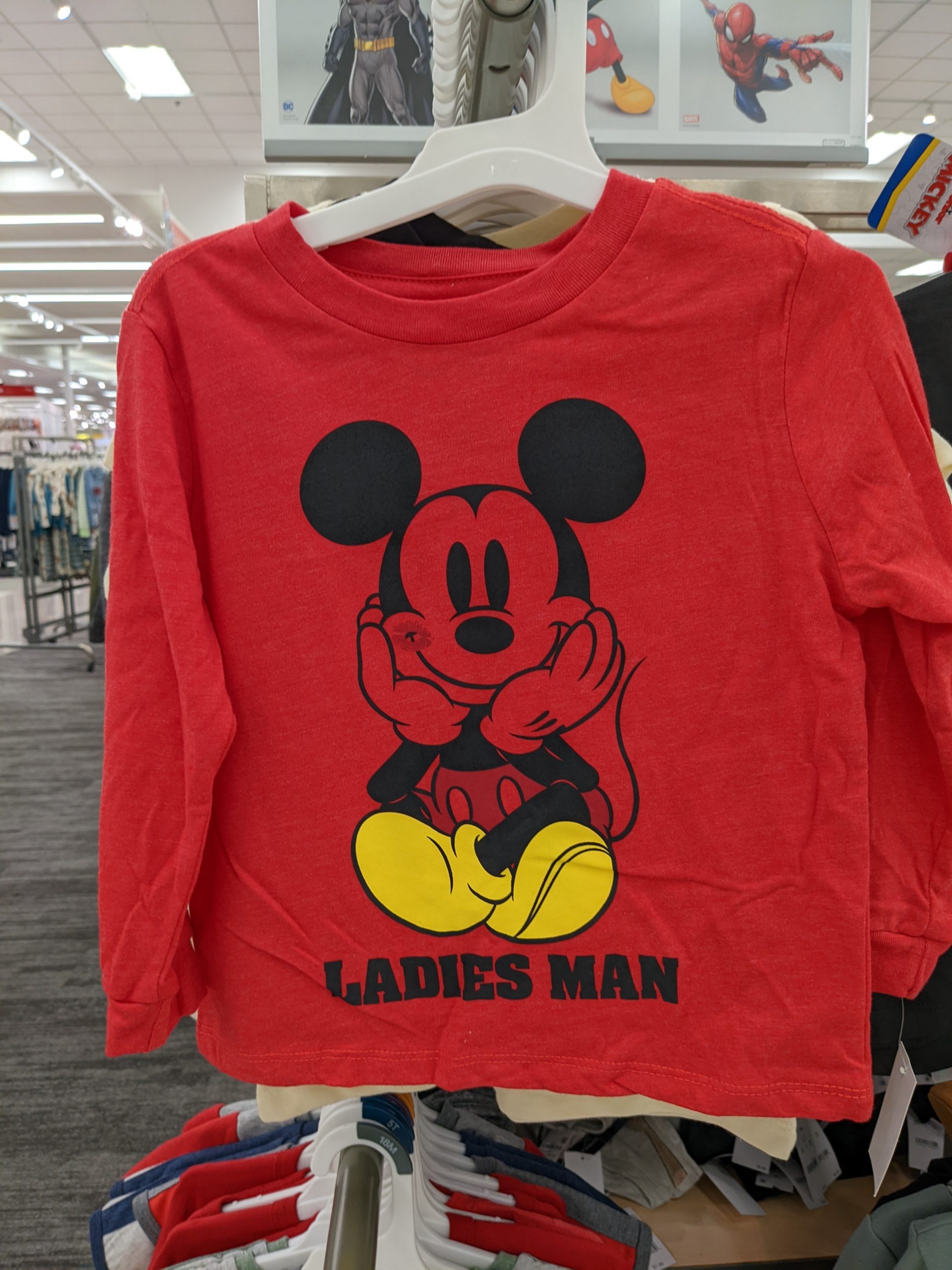 It’s been an interesting experiment having opposite gendered babies who also happen to be mostly bald. My oldest didn’t really start having hair until two. As a result, there was not a whole lot other than clothes for people to identify their gender, and often they just guessed. Most of the time I don’t correct people if they misgender one of my kids, because it isn’t a big deal to me, but often I have found that people ask, wanting to specifically know if they are a boy or a girl. If asked, I will answer. Occasionally if people have guessed wrong, and realize it, they will comment on my child’s clothing, saying something like “What’s that boy doing wearing pink pants?” or “Why doesn’t she have a bow?”. If I am able to, I like to challenge this binary thinking, usually by asking a question back, i.e. “Why can’t boys wear pink pants?”. This usually throws the person off guard and shuts down further questions. As Christia Brown explains in her book Parenting Beyond Pink and Blue, if we want our kids to be free of gender stereotypes, we need to model pushing back for them to see.
It’s been an interesting experiment having opposite gendered babies who also happen to be mostly bald. My oldest didn’t really start having hair until two. As a result, there was not a whole lot other than clothes for people to identify their gender, and often they just guessed. Most of the time I don’t correct people if they misgender one of my kids, because it isn’t a big deal to me, but often I have found that people ask, wanting to specifically know if they are a boy or a girl. If asked, I will answer. Occasionally if people have guessed wrong, and realize it, they will comment on my child’s clothing, saying something like “What’s that boy doing wearing pink pants?” or “Why doesn’t she have a bow?”. If I am able to, I like to challenge this binary thinking, usually by asking a question back, i.e. “Why can’t boys wear pink pants?”. This usually throws the person off guard and shuts down further questions. As Christia Brown explains in her book Parenting Beyond Pink and Blue, if we want our kids to be free of gender stereotypes, we need to model pushing back for them to see.








